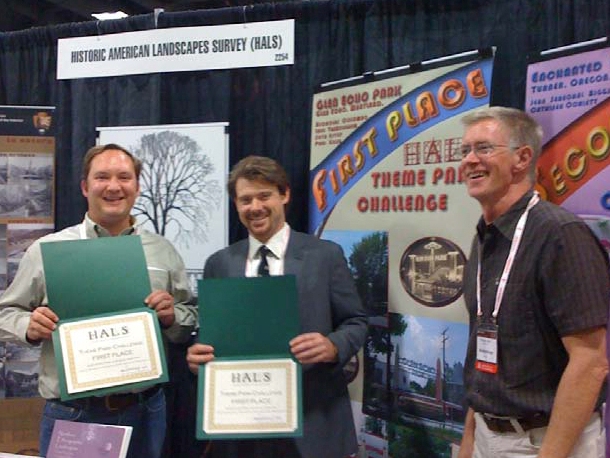Landscape architecture team interprets history of Glen Echo Park to garner first place in 2010 Theme Park Challenge

A Virginia Tech National Capital Region landscape architecture team garnered first place in the Historic American Landscapes Survey competition sponsored by the National Trust for Historic Preservation to document the landscapes of childhood.
Entrants were asked to complete at least one short format history for a historic theme park landscape. Associate Professor Paul Kelsch and three students from the Master of Landscape Architecture Program – Nicholas Colombo and Luke Van Belleghem, both of Arlington, Va., and Seth Estep, of Wise, Va. – chose to interpret the history of Glen Echo Park, Md., a National Park Service arts and culture venue for their 2010 Theme Park Challenge submission.
The team was awarded the top prize for "Topographies of Amusement: The Evolving Terrain of Glen Echo Park" during the recent 2010 American Society of Landscape Architects Annual Meeting and Expo in Washington, D.C.
Glen Echo Park reuses the remaining structures of a former trolley-line amusement park, offering arts and dance classes in a setting where children and adults once delighted to the sights, sounds, and diversions of the trolley park. The existing structures have been studied and restored by the National Park Service, but the landscape that draws these diverse structures into a "topography of amusement" has not been documented. "In writing this history, we cast the landscape as both an agent and a record of the continuous and incremental development of the site. In this way, the natural topography and the constructed amusements are inextricable." Kelsch said.
In their abstract, the team wrote: "Glen Echo sits on a bluff above the Potomac River gorge just upstream of Washington, D.C. This uneven terrain is critical to the history of the [p]ark and the development of its landscape. The most evident geographic feature of the [p]ark is Minnehaha Creek, a small stream in a steep ravine that bisects the site. A gentler swale branches from the stream, and this dendritic pattern of stream and swale serves as an armature for the [p]ark. The relationship between buildings and topography, in various incarnations, has configured the site into a series of distinct landscape places.
"The site evolved over time, embodying three distinct, recreational landscapes. In the 1890s, a Chautauqua retreat transformed the rugged terrain into a secluded destination, yet still close to the capital city. When the Chautauqua closed, the site transitioned into a trolley park, a once-common landscape type in urban areas of the United States in the early 20th century. The National Park Service acquired the property after the trolley park's demise in the 1960s, reinventing it as the arts venue that exists today.
"The current landscape is a palimpsest of this complex history, with traces of former uses still evident in the remaining structures, critical topographic relationships, footprints of earlier rides, and several ruins. The park's many incarnations – and the landscape and architectural features they have left behind – offer a unique encapsulation of urban Americans' shifting attitudes towards recreation. Those shifting values include desegregation of public recreation facilities after important Civil Rights protests at Glen Echo Park. Today, it is the last significant remnant of the trolley park era in Washington, D.C."
The 2010 Theme Park Challenge was initiated to mark the tenth anniversary of the Historic American Landscapes Survey by Chris Pattillo, one of three founders of the Northern California Chapter and founder of PGA design.
The Historic American Landscapes Survey was created in 2000 as a federal program to document historic landscapes in the United States and its territories. Documentation is critical to preserving these significant sites for the benefit of future generations. Like its companion programs, the Historic American Buildings Survey and the Historic American Engineering Record, the Historic American Landscapes Survey produces written and graphic records used by educators, land managers, and preservation planners as well as the general public.
The National Park Service administers its planning and operation, standardizes formats, and develops guidelines for recording landscapes, and catalogs and/or publishes the information when appropriate. The American Society of Landscape Architects provides professional guidance and technical advice for the program through its Historic Preservation Professional Practice Network and The Library of Congress accepts and preserves its documents, furnishes reproductions of material, and makes records available to the public.


